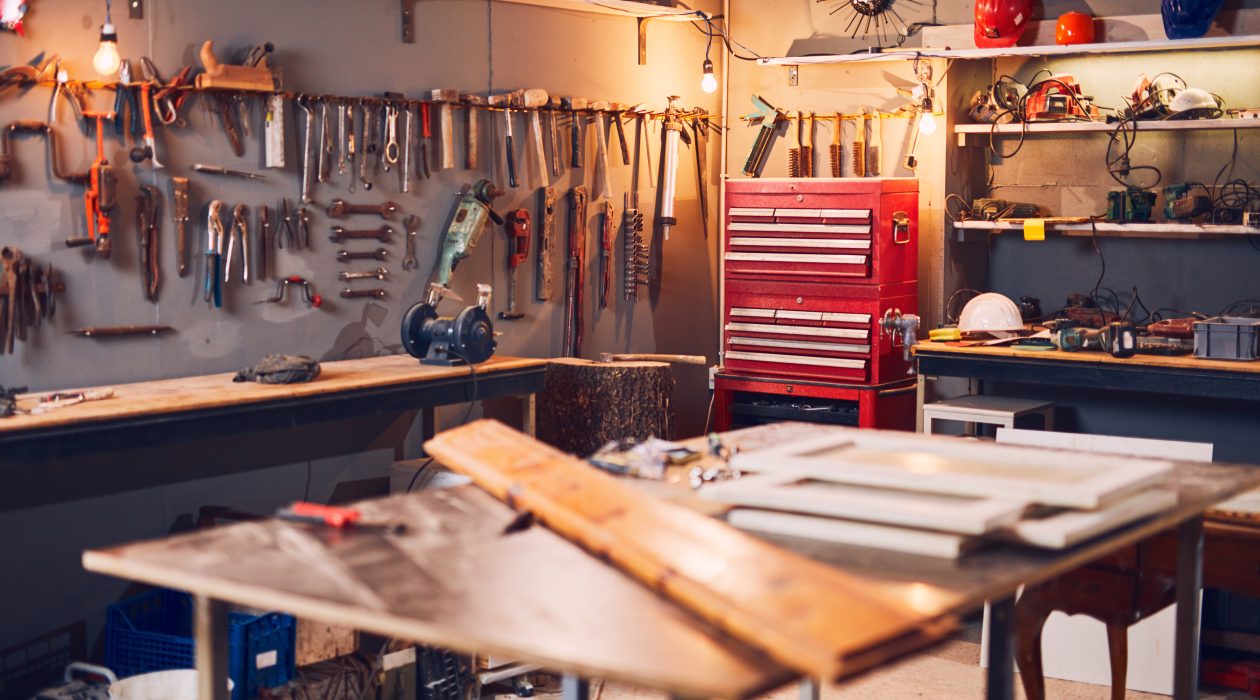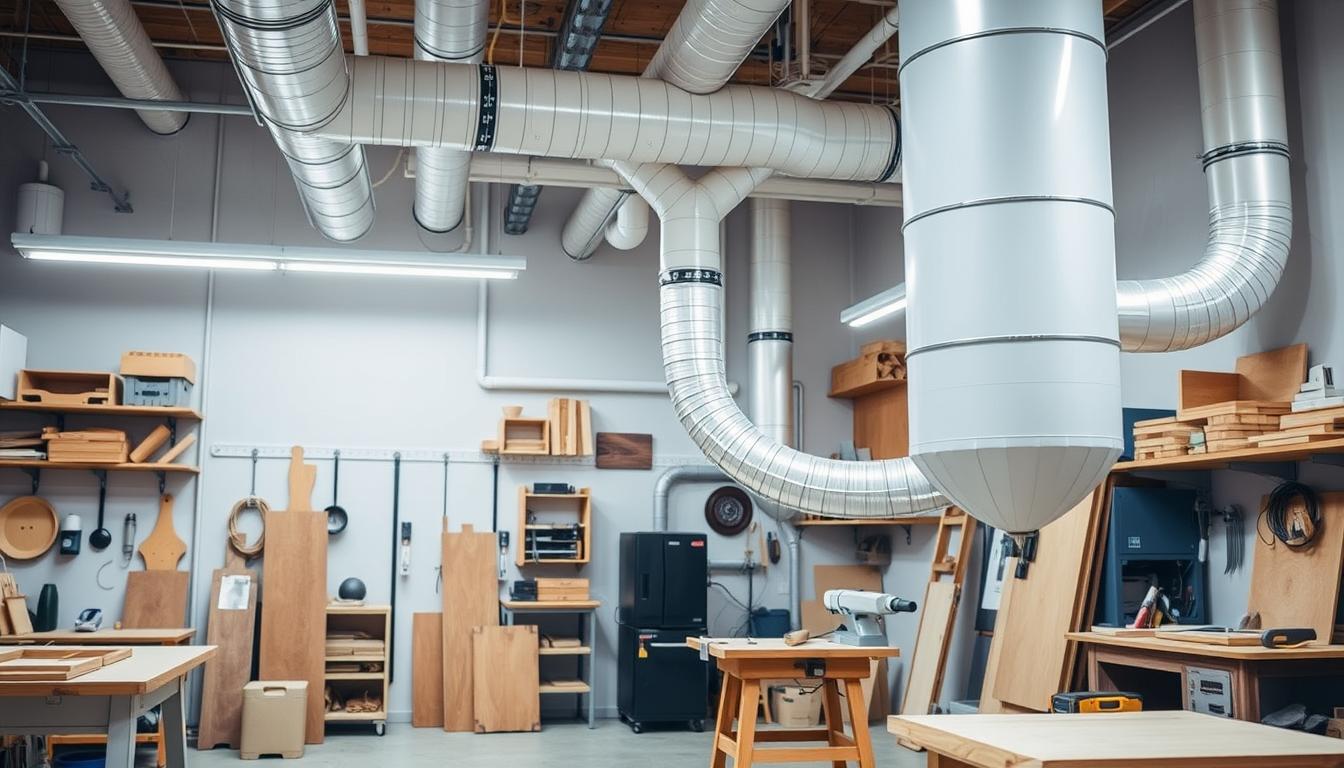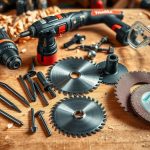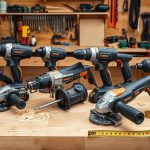Ensuring a clean workspace is vital for a safe and healthy work environment. Dust collection accessories are key in keeping the air clean by removing dust and debris. This action prevents respiratory issues and lowers the risk of fires and explosions. With the right tools, you can maintain a cleaner, safer workspace.
Choosing dust collection accessories is a wise move for any workshop or industrial area. These tools enhance cleanliness and boost productivity and efficiency. By minimizing dust and debris, workers can concentrate on their tasks without health concerns. This results in better work quality and less downtime.
Key Takeaways
- Proper workspace cleanliness is essential for a safe and healthy working environment
- Dust collection accessories effectively remove dust and debris from the air
- Investing in dust collection accessories improves workspace cleanliness and increases productivity
- Dust collection accessories reduce the risk of respiratory problems and fires
- Regular maintenance of dust collection accessories is necessary for optimal performance
- Dust collection accessories are a smart investment for any workshop or industrial setting
- Improved workspace cleanliness leads to higher quality work and reduced downtime
Understanding the Importance of Dust Collection Systems
Dust collection systems are vital in any workshop, crucial for reducing dust inhalation risks. The use of dust removal tools is key to maintaining a clean, safe environment. Prolonged dust exposure can cause serious health risks, including respiratory issues and occupational diseases.
The significance of dust collection systems is immense. They protect workers’ health and play a vital role in environmental conservation. By employing effective dust removal tools, workshops can significantly reduce airborne dust, thus lowering environmental pollution risks.
Health Risks of Workshop Dust
Workshop dust poses significant health risks to workers, including respiratory problems, skin irritation, and eye irritation. Common health issues include:
- Respiratory problems, such as bronchitis and asthma
- Skin irritation and dermatitis
- Eye irritation and conjunctivitis
Environmental Impact of Poor Dust Management
Poor dust management can lead to severe environmental pollution, affecting air and water quality. Effective dust removal tools are essential to mitigate these environmental impacts.
Regulatory Requirements for Dust Control
Workshops must adhere to various dust control regulations. These include the use of dust removal tools and dust control measures to reduce inhalation risks.
| Regulatory Requirement | Description |
|---|---|
| OSHA Regulations | Require workshops to implement dust control measures to minimize the risks associated with dust inhalation |
| EPA Regulations | Require workshops to minimize the environmental impact of poor dust management |
Essential Dust Collection Accessories for Every Workshop
Keeping a workshop clean and safe is paramount. Dust collection accessories play a vital role in this effort. They help reduce airborne dust and debris, improving air quality and safety. By adopting DIY safety tips, workshops can maintain a clean and secure environment for all activities.
Here are some must-have dust collection accessories:
- Dust collectors with HEPA filters to capture 99.97% of particles as small as 0.3 microns
- Portable dust collectors for easy maneuverability and flexibility
- Dust collection hoses and fittings to connect equipment and minimize dust leakage
Investing in these accessories and adhering to DIY safety tips can transform a workspace. It becomes safer and more efficient. Always prioritize DIY safety tips when using power tools and dust collection equipment. This ensures a clean and healthy environment.
For more details on dust collection accessories and DIY safety tips, consult industry experts or online resources. By maintaining a clean and safe workshop, you foster a productive and healthy environment for the long term.
| Dust Collection Accessory | Description |
|---|---|
| Dust Collector | A device that captures dust and debris from the air |
| Portable Dust Collector | A compact and maneuverable dust collector for small workspaces |
| Dust Collection Hose | A flexible hose that connects equipment to the dust collector |
Types of Dust Collection Systems and Their Components
For maintaining workspace cleanliness, a suitable dust collection system is essential. Various systems exist, each with distinct components and advantages. Knowing these systems and their parts aids in selecting the ideal one for your needs, enhancing your dust removal tools effectiveness.
A well-designed dust collection system significantly boosts workspace cleanliness and minimizes dust-related hazards. Key components include dust collectors, ductwork, and dust removal tools like vacuum cleaners and brushes.
Central Dust Collection Systems
Central dust collection systems offer a comprehensive approach to workspace cleanliness. They consist of a central dust collector, ductwork, and a network of branches. These connect to various dust removal tools and machines.
Portable Dust Collectors
Portable dust collectors are perfect for smaller workspaces or specific areas needing workspace cleanliness. They are compact and lightweight, facilitating easy movement and use with different dust removal tools.
Shop Vacuums and Attachments
Shop vacuums and attachments are crucial dust removal tools for workspace cleanliness. These vacuums feature various attachments, such as brushes, crevices, and dusting brushes. They are designed for cleaning diverse surfaces and areas.
| Type of System | Components | Benefits |
|---|---|---|
| Central Dust Collection Systems | Dust collector, ductwork, branches | Comprehensive solution, improved workspace cleanliness |
| Portable Dust Collectors | Compact collector, dust removal tools | Easy to use, ideal for smaller workspaces |
| Shop Vacuums and Attachments | Vacuum, attachments (brushes, crevices, dusting brushes) | Versatile, effective for cleaning different surfaces |
Selecting the Right Dust Collection Accessories for Your Space
When selecting dust collection accessories, DIY safety tips are paramount. A clean, safe workspace is crucial for any project. The right accessories can significantly impact your environment. Assess your workshop’s needs and the projects you’ll undertake to choose wisely.
Start by evaluating your workspace’s size and dust generation. This will guide you in selecting the appropriate dust collection system. Consider the materials you’ll work with, as some may need specific accessories.
- Airflow and suction power
- Filter type and quality
- Noise level and vibration
- Portability and maneuverability
Researching and selecting the right dust collection accessories ensures a safe, healthy workspace. It also protects your equipment and boosts productivity.
Remember, a well-designed dust collection system is essential for maintaining a clean and safe workspace, and with the right accessories, you can achieve optimal results.
Installation and Setup Best Practices
Installing and setting up dust collection systems requires careful attention to detail. Proper installation is key to ensure the system operates efficiently. Dust removal tools are crucial in this process. Following DIY safety tips is essential to avoid accidents and injuries.
To ensure a safe and successful installation, consider the following steps:
- Plan the ductwork layout carefully to minimize twists and turns, which can reduce airflow and system performance.
- Choose the right dust removal tools for the job, such as a vacuum or blower, to ensure efficient dust collection.
- Follow DIY safety tips, such as wearing protective gear and ensuring proper ventilation, to prevent accidents and injuries.
After installation, it’s vital to test and adjust the system for optimal performance. This may involve checking airflow, adjusting ductwork, and ensuring all connections are secure.
By adhering to these best practices and using the appropriate dust removal tools, you can achieve a safe and effective dust collection system. This system will meet your needs and enhance your work efficiency.
| System Component | Installation Tips |
|---|---|
| Ductwork | Plan carefully to minimize twists and turns |
| Vacuum or Blower | Choose the right size and type for the job |
| Connections | Ensure all connections are secure and tight |
Maintenance and Care of Your Dust Collection Equipment
Regular maintenance is key to keeping your dust collection equipment running smoothly. This ensures workspace cleanliness. A well-kept system prevents dust and debris from spreading in the air and on surfaces. This makes your work environment safer and healthier.
To keep your dust collection equipment in top shape, follow these guidelines:
- Check and replace filters regularly to ensure optimal airflow and dust capture.
- Inspect and clean ductwork and vents to prevent blockages and ensure smooth airflow.
- Lubricate moving parts to reduce wear and tear on the equipment.
By sticking to a regular maintenance routine, you can extend your equipment’s lifespan. This ensures it continues to work efficiently, contributing to a cleaner and safer workspace cleanliness.
A clean and well-maintained workspace is not only more efficient, but it also reduces the risk of accidents and injuries, making it a vital aspect of any work environment.
Upgrading Your Existing Dust Collection System
Keeping your workspace clean and safe is crucial. A well-functioning dust collection system is key. Over time, your system might need upgrades for better performance. Dust removal tools can help enhance your system’s capabilities, ensuring a healthy work environment.
To upgrade your dust collection system, consider these options:
- Assess your current system’s performance and identify areas for improvement
- Research and invest in dust removal tools that cater to your specific needs
- Implement DIY safety tips to minimize risks and ensure a smooth upgrade process
By adopting these strategies, you can upgrade your dust collection system effectively. This reduces dust-related hazards and makes your workspace safer. Always prioritize DIY safety tips when using dust removal tools for a successful upgrade.
Upgrading your dust collection system is vital for a clean, safe, and efficient workspace. Using the right dust removal tools and following important DIY safety tips will improve your system’s performance. This creates a healthier work environment.
Safety Features and Emergency Protocols
Ensuring workspace cleanliness is vital for accident prevention and a safe work environment. Utilizing dust removal tools and adhering to DIY safety tips is key. A clean workspace significantly lowers the risk of fires, explosions, and other dangers.
Some critical safety features to consider include:
- Proper ventilation systems to remove dust and debris
- Fire extinguishers and emergency exit routes
- Personal protective equipment, such as masks and gloves
Having emergency protocols in place is also essential. This includes a first aid kit and a plan for accident responses. By focusing on workspace cleanliness and following DIY safety tips, individuals can significantly reduce injury risks and ensure a safe work environment.
By implementing these precautions and employing the correct dust removal tools, individuals can maintain a clean and safe workspace. This approach reduces accident risks and promotes a healthy work environment.
| Safety Feature | Importance |
|---|---|
| Proper ventilation | Removes dust and debris, reducing fire risk |
| Fire extinguishers | Responds to fires and explosions |
| Personal protective equipment | Protects individuals from injury |
Conclusion: Maximizing Workshop Safety and Efficiency
In wrapping up our discussion on dust collection accessories, it’s evident that a clean workspace cleanliness is crucial for safety and efficiency. Investing in the right dust removal tools and adhering to DIY safety tips is essential. This allows woodworkers, hobbyists, and professionals to work in a healthier, more efficient environment.
This article has underscored the significance of thorough dust management. It covers health risks, environmental impact, and regulatory needs. Having the correct dust collection accessories is vital for a safe, efficient DIY project.
Choosing between a centralized dust collection system, portable collectors, or shop vacuums depends on your needs and space. Proper installation, maintenance, and upgrades are key to effective dust control. This ensures a clean, productive workspace.



